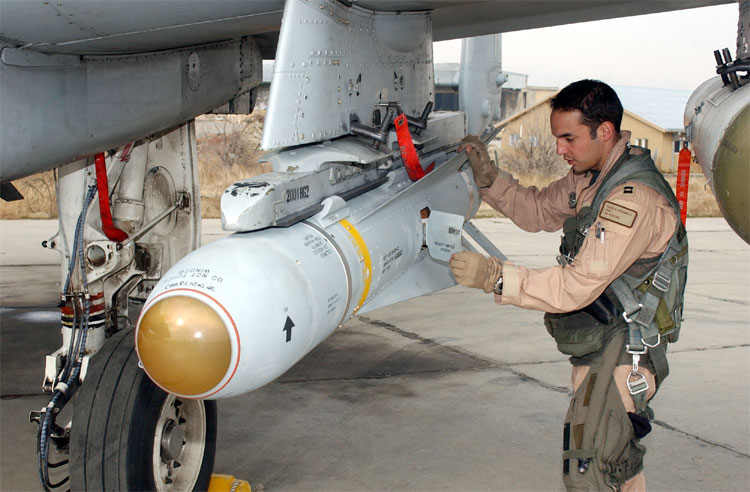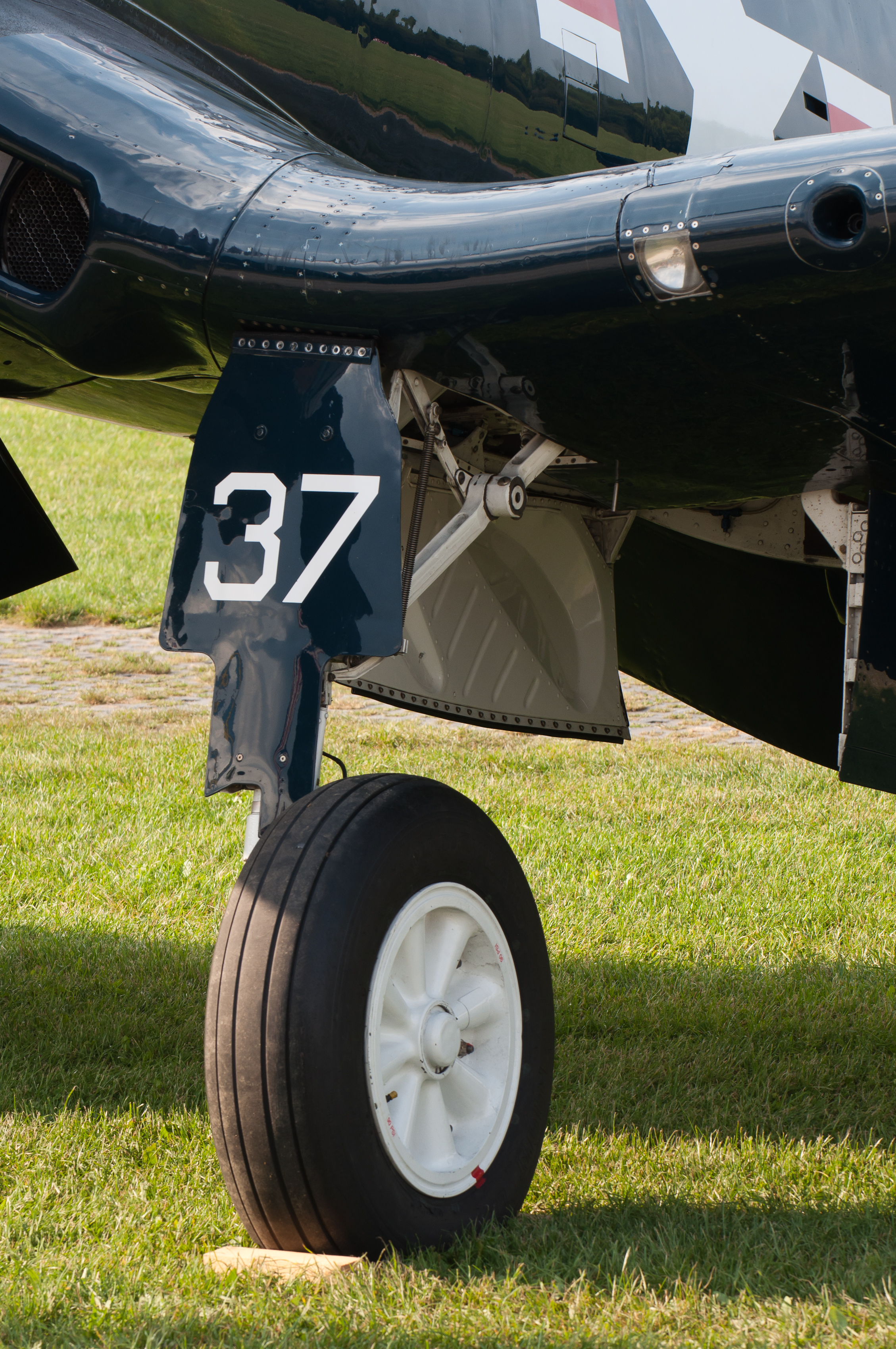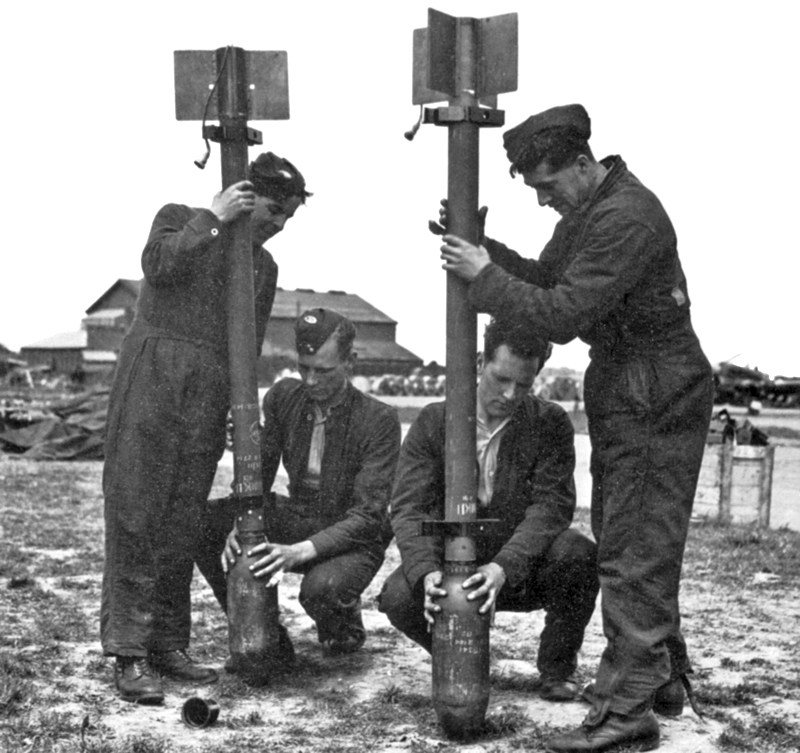|
5-Inch Forward Firing Aircraft Rocket
The five-inch forward-firing aircraft rocket or FFAR was an American rocket developed during World War II for attack from airplanes against ground and ship targets. Operational history The first FFARs were developed by the U.S. Navy and introduced in June 1943. They had a 3.5-inch diameter and a non-explosive warhead, since they were used as an aircraft-launched anti-submarine warfare (ASW) rocket and worked by puncturing the hull. It was accurate enough for use against surface ships and land targets, but these missions required an explosive warhead.Parsch 2004 A five-inch anti-aircraft shell was attached to the 3.5-inch rocket motor, creating the five-inch FFAR, which entered service in December 1943. Performance was limited because of the increased weight, limiting speed to 780 km/h (485 mph).Parsch 2006 The high-velocity aircraft rocket, or HVAR, was developed to fix this flaw. The FFAR was used by the Douglas SBD Dauntless (dive bomber), the Grumman TBF Avenger ( ... [...More Info...] [...Related Items...] OR: [Wikipedia] [Google] [Baidu] |
Air-to-surface Missile
An air-to-surface missile (ASM) or air-to-ground missile (AGM) is a missile designed to be launched from military aircraft at targets on land or sea. There are also unpowered guided glide bombs not considered missiles. The two most common propulsion systems for air-to-surface missiles are rocket motors, usually with shorter range, and slower, longer-range jet engines. Some Soviet Union, Soviet-designed air-to-surface missiles are powered by ramjets, giving them both long range and high speed. Missile guidance, Guidance for air-to-surface missiles is typically via laser guidance, infrared homing, infrared guidance, optical guidance or via satellite guidance signals. The type of guidance depends on the type of target. Ships, for example, may be detected via passive radar or active radar homing, which is less effective against multiple, small, fast-moving land targets. There is some cross-over between air-to-surface missiles and surface-to-surface missiles. For example, there was ... [...More Info...] [...Related Items...] OR: [Wikipedia] [Google] [Baidu] |
Vought F4U Corsair
The Vought F4U Corsair is an American fighter aircraft that saw service primarily in World War II and the Korean War. Designed and initially manufactured by Vought, Chance Vought, the Corsair was soon in great demand; additional production contracts were given to Goodyear Aerospace, Goodyear, whose Corsairs were designated FG, and Brewster Aeronautical Corporation, Brewster, designated F3A. The Corsair was designed and principally operated as a carrier-based aircraft, and entered service in large numbers with the U.S. Navy and Marines in World War II. It quickly became one of the most capable carrier-based fighter-bombers of the war. Some Japanese pilots regarded it as the most formidable American fighter and U.S. naval aviators achieved an 11:1 kill ratio. Early problems with carrier landings and logistics led to it being eclipsed as the dominant carrier-based fighter by the Grumman F6F Hellcat, powered by the same Pratt & Whitney R-2800 Double Wasp, Double Wasp engine first f ... [...More Info...] [...Related Items...] OR: [Wikipedia] [Google] [Baidu] |
World War II Weapons Of The United States
The world is the totality of entities, the whole of reality, or everything that exists. The nature of the world has been conceptualized differently in different fields. Some conceptions see the world as unique, while others talk of a "plurality of worlds". Some treat the world as one simple object, while others analyze the world as a complex made up of parts. In scientific cosmology, the world or universe is commonly defined as "the totality of all space and time; all that is, has been, and will be". Theories of modality talk of possible worlds as complete and consistent ways how things could have been. Phenomenology, starting from the horizon of co-given objects present in the periphery of every experience, defines the world as the biggest horizon, or the "horizon of all horizons". In philosophy of mind, the world is contrasted with the mind as that which is represented by the mind. Theology conceptualizes the world in relation to God, for example, as God's creation, ... [...More Info...] [...Related Items...] OR: [Wikipedia] [Google] [Baidu] |
Air-to-ground Rockets Of The United States
Air-to-ground weaponry is aircraft ordnance used by combat aircraft to attack ground targets. The weapons include bombs, machine guns, autocannons, air-to-surface missiles, rockets, air-launched cruise missiles and grenade launchers. See also * Aircraft ordnance * Attack aircraft * Gunship * Close air support Close air support (CAS) is defined as aerial warfare actions—often air-to-ground actions such as strafes or airstrikes—by military aircraft against hostile targets in close proximity to friendly forces. A form of fire support, CAS requires ... References Aircraft weapons {{Aero-stub ... [...More Info...] [...Related Items...] OR: [Wikipedia] [Google] [Baidu] |
Zuni (rocket)
The Zuni 5-inch Folding-Fin Aircraft Rocket (FFAR), or simply Zuni, is a unguided rocket developed by the Hunter Douglas Division of Bridgeport Brass Company and deployed by the United States Armed Forces, and the French Air Force. The rocket was developed for both air-to-air and air-to-ground operations. It can be used to carry various types of warheads, including chaff for countermeasures. It is usually fired from the LAU-10 rocket pod holding four rockets. Development In the early 1950s, U.S. Navy engineers at Naval Ordnance Test Station China Lake began to develop a new 12.7 cm unguided rocket to replace the High Velocity Aircraft Rocket. The Zuni was designed as a modular system, to allow the use of different types of warheads and fuzes. One type of warhead had a proximity fuze, as the rocket was originally intended to be used as an air-to-air rocket. This led to its selection as the basis for the AIM-9 Sidewinder airframe in the early 1950s. The Zuni was approved ... [...More Info...] [...Related Items...] OR: [Wikipedia] [Google] [Baidu] |
RP-3
The RP-3 (from Rocket Projectile 3 inch) was a British air-to-ground rocket (weapon), rocket projectile introduced during the Second World War. The "3 inch" designation referred to the nominal diameter of the rocket motor tube. The use of a warhead gave rise to the alternative name of the "60-pound rocket". Though an air-to-ground weapon, it saw limited use in other roles. They were generally used by British fighter-bomber aircraft against targets such as tanks, trains, motor transport and buildings, as well as by Coastal Command and Royal Navy aircraft against U-boats and ships. Use continued post-war, with the last known major operational use being during the Aden Emergency in 1964, where Hawker Hunters flew 642 sorties and fired 2,508 RP-3s in support of Radforce. Use continued until the withdrawal from Aden Protectorate in November 1967, at which point the RP-3 was withdrawn from service in favour of the newer SNEB. Concerned about the possibility of shipboard radar setting of ... [...More Info...] [...Related Items...] OR: [Wikipedia] [Google] [Baidu] |
List Of Rockets
There are several different types of rockets. The following articles contain lists of rockets by type: * List of missiles * List of orbital launch systems * List of sounding rockets * List of military rockets * List of rocket stages * List of canceled launch vehicle designs See also * Comparison of orbital launch systems * Comparison of orbital launchers families * Comparison of space station cargo vehicles * Comparison of orbital rocket engines * Comparison of solid-fuelled orbital launch systems * List of space launch system designs * * List of rocket aircraft * Lists of weapons * Model rocket * NATO reporting name NATO uses a system of code names, called reporting names, to denote military aircraft and other equipment used by post-Soviet states, former Warsaw Pact countries, China, and other countries. The system assists military communications by providi ... (has lists of various Soviet missiles) {{DEFAULTSORT:Rockets *Rockets lists ... [...More Info...] [...Related Items...] OR: [Wikipedia] [Google] [Baidu] |
Mk 4/Mk 40 Folding-Fin Aerial Rocket
The Mk 4 Folding-Fin Aerial Rocket (FFAR), also known as "Mighty Mouse", is an unguided rocket used by United States military aircraft. It was 2.75 inches (70 mm) in diameter. Designed as an air-to-air weapon for interceptor aircraft to shoot down enemy bombers, it primarily saw service as an air-to-surface weapon. The FFAR has been developed into the modern Hydra 70 series, which is still in service. History The advent of jet engines for fighters and bombers posed new problems for interceptors. With closing speeds of 1,500 ft/s (457 m/s) or more for head-on interceptions, the time available for a fighter pilot to successfully target an enemy aircraft and inflict sufficient damage to bring it down was increasingly small. Wartime experience had shown that .50 caliber (12.7 mm) machine guns were not powerful enough to reliably down a bomber, certainly not in a single volley, and heavy autocannons did not have the range or rate of fire to ensure a hit. Ungu ... [...More Info...] [...Related Items...] OR: [Wikipedia] [Google] [Baidu] |
Grumman TBF Avenger
The Grumman TBF Avenger (designated TBM for aircraft manufactured by General Motors) is an American World War II-era torpedo bomber developed initially for the United States Navy and Marine Corps, and eventually used by several air and naval aviation services around the world. The Avenger entered U.S. service in 1942, and first saw action during the Battle of Midway. Despite the loss of five of the six Avengers on its combat debut, it survived in service to become the most effective submarine killer and most widely-used torpedo bomber of World War II, sharing credit for sinking the super-battleships and and being credited for sinking 30 submarines. Greatly modified after the war, it remained in use until the 1960s.Wheeler 1992, p. 53. From 1942-on, production of the Avenger (in fact nearly three quarters of its the total production) was subcontracted to a purposely established division of General Motors: the Eastern Aircraft Division. Design and development The Dougl ... [...More Info...] [...Related Items...] OR: [Wikipedia] [Google] [Baidu] |
United States Military
The United States Armed Forces are the Military, military forces of the United States. U.S. United States Code, federal law names six armed forces: the United States Army, Army, United States Marine Corps, Marine Corps, United States Navy, Navy, United States Air Force, Air Force, United States Space Force, Space Force, and the United States Coast Guard, Coast Guard. Since 1949, all of the armed forces, except the Coast Guard, have been permanently part of the United States Department of Defense. They form six of the eight uniformed services of the United States. Each of the different military services is assigned a role and domain. The Army conducts land operations. The Navy and Marine Corps conduct maritime operations, the Marine Corps specializing in amphibious and maritime littoral operations primarily for supporting the Navy. The Air Force conducts air operations. The Space Force conducts space operations. The Coast Guard is unique in that it specializes in maritime opera ... [...More Info...] [...Related Items...] OR: [Wikipedia] [Google] [Baidu] |
Douglas SBD Dauntless
The Douglas SBD Dauntless is a World War II American naval scout plane and dive bomber that was manufactured by Douglas Aircraft from 1940 through 1944. The SBD ("Scout Bomber Douglas") was the United States Navy's main Carrier-based aircraft, carrier-based scout/dive bomber from mid-1940 through mid-1944. The SBD was also flown by the United States Marine Corps, both from land air bases and aircraft carriers. The SBD is best remembered as the bomber that delivered the fatal blows to the Japanese carriers at the Battle of Midway in June 1942.Parker, Dana T. ''Building Victory: Aircraft Manufacturing in the Los Angeles Area in World War II,'' pp. 25–34, Cypress, CA, 2013. . The type earned its nickname "Slow But Deadly" (from its SBD initials) during this period. During its combat service, the SBD proved to be an effective naval scout plane and dive bomber. It possessed long range, good handling characteristics, maneuverability, potent bomb load, great diving characteristics fr ... [...More Info...] [...Related Items...] OR: [Wikipedia] [Google] [Baidu] |
High Velocity Aircraft Rocket
The High Velocity Aircraft Rocket, or HVAR, also known by the nickname Holy Moses, was an American unguided rocket developed during World War II to attack targets on the ground from aircraft. It saw extensive use during both World War II and the Korean War. Design and development The HVAR was designed by engineers at Caltech during World War II as an improvement on the 5-Inch Forward Firing Aircraft Rocket (FFAR), which had a diameter warhead but an underpowered diameter rocket motor. The desire for improved accuracy from the flatter trajectory of a faster rocket spurred the rapid development. HVAR had a constant 5-inch diameter for both warhead and rocket motor, increasing propellant from of Ballistite. U.S. Ballistite propellant had a sea level specific impulse of over , compared with about for the British Cordite, German WASAG and Soviet PTP propellants. Hercules Powder Company was the principal U.S. supplier of high performance extruded Ballistite propellants: 51.5% nitr ... [...More Info...] [...Related Items...] OR: [Wikipedia] [Google] [Baidu] |








